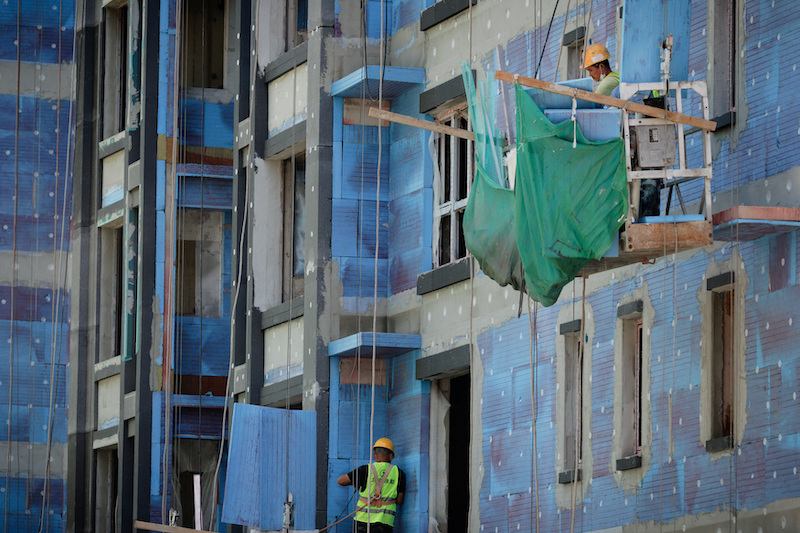China’s economic slowdown has crimped local government’s spending power by nearly $1 trillion, according to calculations based on data from provincial governments.
This has hit the 31 provincial regions’ capacity to fund infrastructure or allow tax cuts, and is likely to cause economic problems in 2023, as well as the final quarter this year.
Times are tough for policymakers in Beijing, as the economy falters in the face of a deteriorating global outlook, with rising commodity costs, geopolitical tensions and widespread Covid restrictions.
This has cast a big shadow over latest party congress, which began on Sunday.
Local governments have long been a pump-primer of China’s development, but a drop in land sales revenue in the wake of the country’s property crisis and a crackdown on undeclared debts has severely eroded their financial power.
And this year China’s situation has been aggravated by weak income growth and crippling Covid restrictions that may not end till the second quarter of 2023.
Local governments must also make loan payments in the coming months, suggesting there is more financial pain ahead and limits on their ability to meet Beijing’s requests to boost spending.
Many have already resorted to pay cuts, reducing workforce, cutting subsidies and even imposing disproportionately heavy fines to make up for budget shortfalls.
In the first eight months, China’s 31 provincial-level regions reported a gap between public revenue and expenditure of 6.74 trillion yuan ($948 billion).
That is the most for the period since at least 2012, calculations from local government data over the past decade showed, with the populous provinces of Sichuan, Henan, Hunan and Guangdong suffering the largest shortfalls.
In the same period, government land sales, counted separately, tumbled 28.5% year-on-year to 3.37 trillion yuan, adding urgency to the need to restore the financial health of indebted real estate firms.
“With the slower growth this year, we expect fiscal deficits for regional and local governments will remain substantial, reflecting the property slowdown and lingering effects of the coronavirus shock,” said Jennifer Wong, an analyst at Moody’s, which expects 2022 economic growth to slow to 3.5% from 8.1% in 2021.
In the past, shortfalls were largely offset by transfer payments from the central government and carryover funds from previous years, but analysts say cooling economic growth may limit any such help this time around.
ALSO SEE:
‘Huge’ Dollar Buying by China State Banks to Bolster Yuan
Local Government Debts Peak Next Year
Policymakers will also be wary of picking up the fiscal slack with large-scale monetary stimulus as a wave of global interest rate hikes to rein in red-hot inflation has sent US bond yields soaring, widening the yield gap between US and Chinese debt.
Treasury bond quotas could be increased, so that some of them could be transferred to local governments to ease their fiscal stress, said Luo Zhiheng, chief macroeconomic analyst at Yuekai Securities.
However, they face a squeeze on their already tight cash-flows as maturing local government debts peak in 2023 for the 2021-2025 period, Luo warned.
Combined with some maturing debts of local government financing vehicles (LGFVs) – investment companies that build infrastructure projects – this year and the next will be most stressful for local governments, he said.
Around 380 billion yuan ($52.8 billion) of onshore LGFV bonds from economically weaker provinces are due for repayment in the next 12 months, according to a Moody’s report in August.
Such fiscal constraints, together with weakening exports, doubts over a consumption revival and external uncertainties such as the war in Ukraine, would add pressure on policymakers to shore up the economy in 2023, Nie Wen, a Shanghai-based economist at Hwabao Trust, said.
Nie is forecasting GDP growth of 5.5% next year, assuming few or no Covid disruptions, better than the broad 3.2% consensus for this year but still lagging the pre-pandemic 6.0% pace in 2019.
Small Business Fines Jump 10%
Highlighting the pressure on finances, the provinces of Shandong, Shanxi, Henan, Zhejiang, as well as the municipality of Tianjin said they had all shed budgeted head counts at government agencies in recent months.
Moreover, some grassroots market regulators have even imposed excessively high fines on small businesses to boost revenue.
According to financial media outlet Yicai, local governments’ revenue from fines and confiscations jumped 10.4% in January-July year-on-year.
Additional spending to contain Covid outbreaks has also strained local government finances. The fiscal stress is cutting into some households’ income, a red flag for consumption and broader growth.
“My annual income was slashed by 27% to around 80,000 yuan last year, due to the very heavy local fiscal burden,” an employee surnamed Gao at a government agency in Chongqing said.
“Our leaders were very anxious these days, as they said the current fiscal allocation is not enough at all. As there is no way out, they have had to ask the local government fiscal department for money.”
- Reuters with additional editing by Jim Pollard
ALSO SEE:
Apple Defers Plan to Use China’s YMTC Chips – Nikkei
We Will Never Rule Out Using Force on Taiwan: Xi Jinping
























